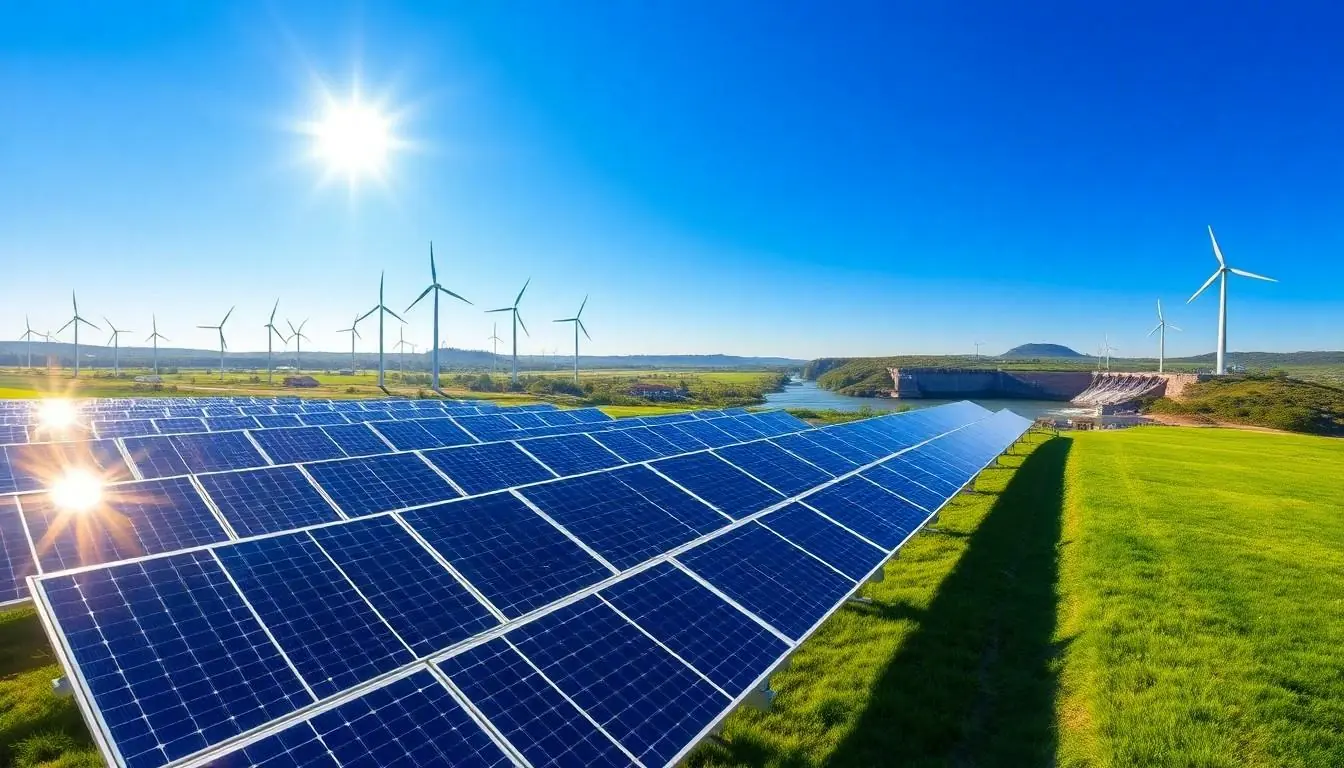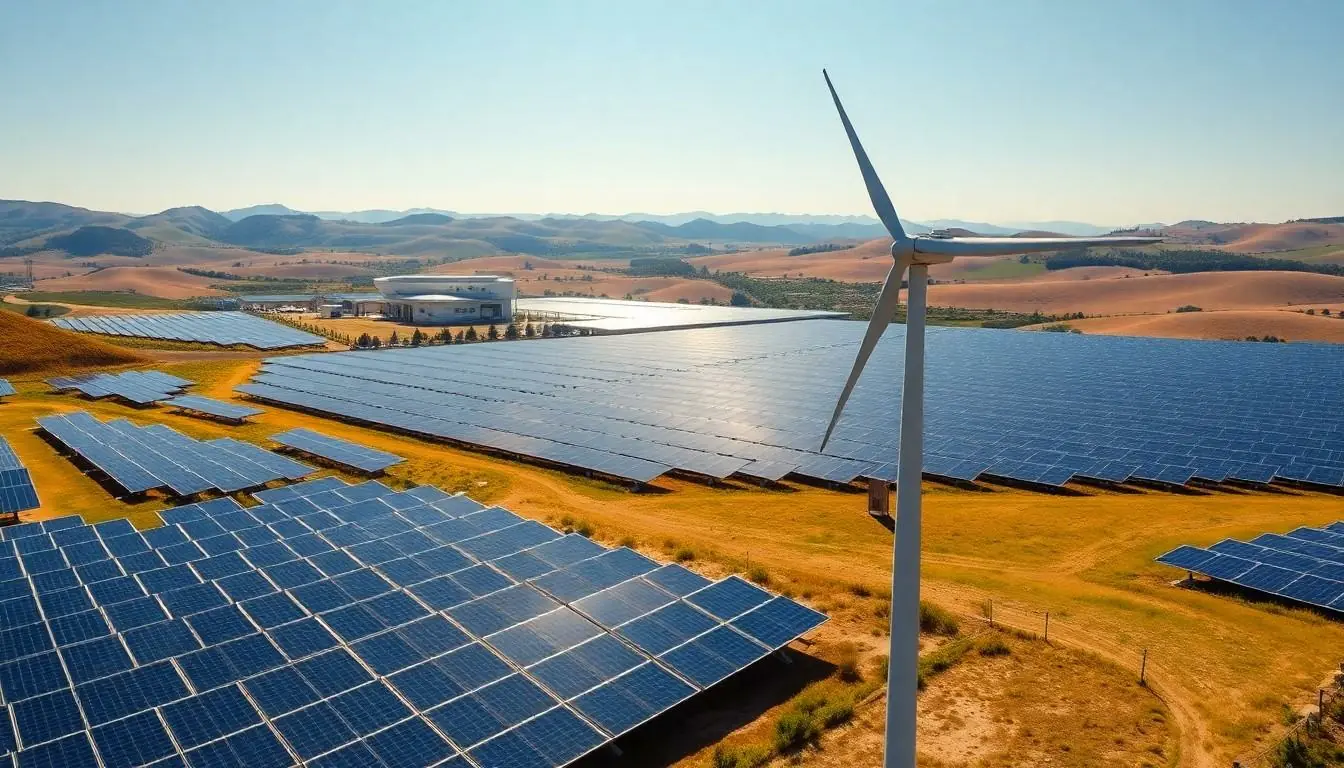In a world where energy demands soar and climate change looms like a bad haircut, the quest for renewable energy sources has never been more crucial. Imagine harnessing the power of the sun or the wind, all while giving fossil fuels the boot. It’s like trading in a clunky old car for a sleek electric ride—better for the planet and surprisingly more fun!
Table of Contents
ToggleUnderstanding Renewable Energy
Renewable energy refers to sources of energy that naturally replenish over time. Solar power harnesses energy from the sun, making it a sustainable option for electricity generation. Wind energy captures the movement of air through turbines, providing another clean alternative. Geothermal energy uses heat from the earth’s core, offering reliability and consistency.
Hydroelectric power generates energy from flowing water, typically using dams. Biomass energy relies on organic materials such as plant and animal waste, converting them into fuel. As a result, these sources significantly reduce greenhouse gas emissions compared to fossil fuels.
Transitioning to renewable energy sources decreases reliance on finite resources. This shift mitigates environmental impacts and promotes sustainable practices. Various countries actively invest in renewable projects, recognizing their importance for future energy needs.
Governments often incentivize the adoption of renewables through subsidies and tax breaks, encouraging more businesses and households to participate. Technological advancements continue to enhance the efficiency and reduce costs associated with renewable energy systems.
Adopting renewable sources plays a crucial role in addressing climate change and enhancing energy security. By diversifying energy portfolios, countries can stabilize their economies and protect against fluctuating fossil fuel prices. In sum, embracing renewable energy sources leads to a more sustainable and environmentally friendly future.
Types of Renewable Energy Sources

Various renewable energy sources play a significant role in reducing environmental impacts while meeting energy demands. The following subheadings examine each type in detail.
Solar Energy
Solar energy harnesses sunlight through photovoltaic cells, converting it into electricity. This renewable source benefits from abundance, with the sun providing energy to the Earth every day. Systems can be installed on rooftops or in solar farms, allowing for localized generation. Incentives encourage residential and commercial installations, further increasing capacity. The global solar capacity reached over 900 gigawatts in 2023, marking a 20% increase from the prior year.
Wind Energy
Wind energy captures kinetic energy from wind using turbines. These turbines can generate substantial power, especially in areas with consistent wind patterns. In 2022, wind energy accounted for around 8.4% of total electricity generation in the United States. Large-scale wind farms consist of multiple turbines, optimizing land use while providing clean energy. Offshore installations are becoming more common, expanding potential areas for wind power generation.
Hydropower
Hydropower relies on flowing water to generate electricity. Dams and river systems play crucial roles in harnessing this energy. This source constitutes nearly 37% of renewable electricity in the United States, making it the largest contributor. Environmental considerations are essential, as water ecosystems can be affected. Technology advancements improve turbine efficiency, minimizing environmental disruptions.
Biomass Energy
Biomass energy converts organic materials like plant matter and waste into usable energy. This process results in biofuels and biogas, which can replace fossil fuels in various applications. Many countries utilize biomass as a waste management strategy, reducing landfill waste while producing energy. Approximately 5% of the total U.S. energy consumption comes from biomass sources. Sustainable practices in biomass production ensure long-term viability and environmental protection.
Geothermal Energy
Geothermal energy taps into heat from Earth’s interior, harnessing steam or hot water from underground reservoirs. This source provides a reliable, consistent energy supply, unlike solar or wind systems, which fluctuate. Geothermal plants can operate continuously, contributing significantly to energy grids. In 2022, geothermal energy contributed about 0.4% of the electricity generated in the U.S. Technological advancements in exploration and drilling techniques make this resource more accessible.
Comparing Renewable Energy Sources
Renewable energy sources offer numerous advantages that contribute to a sustainable future. Positive impacts on the environment stand out clearly, as these sources significantly lower greenhouse gas emissions compared to fossil fuels. Cost-effectiveness emerges as another benefit. For instance, the global capacity for solar energy reached over 900 gigawatts in 2023, marking a 20% increase from the previous year. Job creation also plays a role; renewable energy sectors, such as wind and solar, continue to expand, providing millions of jobs worldwide. Enhanced energy security arises from diversifying energy portfolios, reducing dependence on finite resources.
Challenges in renewable energy development necessitate attention. One key issue involves intermittency. Solar and wind energy depend on weather conditions, which can cause fluctuations in energy supply. Storage solutions must improve to address this hurdle. Furthermore, the initial investment costs remain significant in some cases, impacting adoption rates. Environmental considerations, particularly for hydropower, require careful management to mitigate ecological damage. Infrastructure upgrades are also necessary to accommodate the growing demand for renewable energy, ensuring efficient integration into existing grids.
The transition to renewable energy sources is more than just a trend; it’s a necessity for a sustainable future. By embracing solar, wind, hydroelectric, biomass, and geothermal energy, society can significantly reduce its carbon footprint and reliance on finite resources.
Investments in these technologies not only foster environmental benefits but also drive economic growth through job creation in emerging sectors. As advancements continue to enhance efficiency and lower costs, the path to a cleaner energy landscape becomes clearer.
The commitment to renewable energy is essential for tackling climate change and securing a stable energy supply for generations to come.




